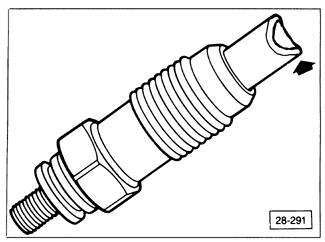6.1 Testing and Replacing Glow PlugsThe glow plugs themselves are the part of the system most likely to cause a problem during normal use. Due to their constant exposure in the combustion chamber, they are subject to carbon build-up and wear, and they have a limited life. Other potential glow plug problems are over-torquing on installation, or wear due to malfunctioning fuel injectors. To check the glow plugs, disconnect the wire from the glow plug bus bar, and remove the bus bar from each of the glow plug terminals. Connect one probe of a test light to the battery's positive (+) terminal, and touch the other probe to each of the glow plugs. The test light should come on when it is touched to each glow plug. If not, that plug is faulty and should be replaced. If the test light does not light at all, voltage may not be reaching the bus bar connection due to a problem in the system circuit. See 6.2 Testing and Repairing Glow Plug System Circuits. Another test of glow plugs is how much electrical current they draw. Disconnect the engine temperature sensor and reconnect the bus bar. Connect an ammeter in series between the glow plug bus bar and the wire which connects to it. Turn the ignition on, for a maximum of 15 seconds, and notice the current measurement. After an initial surge, the total current draw should drop to a steady 48 amperes (12 amps per glow plug). If the current draw is not steady, or is less than 48 amperes, one or more glow plugs is faulty. To find the faulty glow plug, remove the bus bar and repeat the previous test, measuring current flow to each individual glow plug. Replace any plug that is drawing less than 12 amperes. Finally, check the glow plugs by removing and inspecting them. Replace a glow plug if it has been over-torqued, as shown in Fig. 6-1, or if the tip is burned away, as shown in Fig. 6-2. Worn away tips can be caused by malfunctioning fuel injectors. See FUEL SYSTEM-DIESEL for fuel injector pressure testing. Clean off carbon deposits before reinstalling used glow plugs. When installing glow plugs, clean the glow plug holes and seats in the cylinder head. Tighten the plugs to the correct torque of 30 Nm (22 ft. lb.). Use new self-locking nuts when installing the bus bar.


|